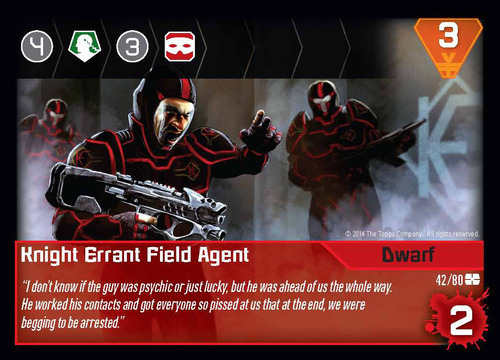Magic! Metahumans! Cyber-hacking! Cyber-augments! Well, there's a reason there's a number of fans of the Shadowrun universe. Enough so that it spawned Shadowrun: Crossfire, a cooperative deckbuilding game with a campaign mode attached. You earn Karma points to give your character upgrades; it's really cool, but not the specific element of Crossfire that I'm talking about on this post. This week, I'm talking about the core system of the game, and how it gives a particular character to the obstacles you fight.
In Crossfire, the players are Runners trying to complete a mission. They do this by encountering Obstacles like a corporate hacker or a vicious vampire. Defeating Obstacles quickly means that runners can keep the overall threat level down and heal back up. Fail to defeat Obstacles, and you start taking damage from them. So how do you defeat Obstacles? You have to deal damage to them by playing cards. It sounds straightforward, right? Cards generate damage in four flavors (the Social flavor, the Fighty flavor, the Hacking flavor, and the Pew Pew Magic flavor), and you need certain types of damage to beat back an Obstacle. There's just two catches.
One, it's usually impossible to beat an Obstacle in one go, because you don't have enough cards. So you have to deal damage to it one bit at a time.
Two, you can't deal damage in any particular way that you want. There's a specific order that you have to do it in, and you have to deal one step at a time. Here's a picture to show you what I mean.
The damage you need to beat this Obstacle is in the top-left corner of the card. 4 of any damage, then 1 Hacking damage, then 3 of any damage, then 1 Social damage. See how it's broken down into four steps? On your turn, you have to deal enough damage to take out the first step (the 4 damage) before you can get working on the next step, and you have to deal enough damage to take out a step entirely; you can't deal 3 damage to this Obstacle and leave the last damage for your teammates to finish off. So you need to get up enough damage to hit the Obstacle hard, then follow it up with some targeted Hacking, then hit it hard with another shot of damage, and finish the job with Social legwork.
What This Does in the Game
Each player takes on a different role: Street Samurai, Face, Decker, and Mage. As you might suspect, each role specializes in one of the four types of damage, and doesn't have a lot of the other types. (In fact, each role begins with 4 cards of one damage type and 1 card of the other three damage types, for 7 total cards.) Roles can buy more cards to diversify the types of damage they deal, but they're still heavily focused on one type. This usually means that one role has to rely on their teammates to bypass an obstacle. A Social character's gonna have a hard time breaking through that Hacking step without their lone Hacking card. This creates chokepoints that the team has to work together to bypass, so there's a bit of back-and-forth. I'm reminded of Neuromancer, where a hacker and a street samurai were working on missions in tandem to bypass different elements of their opposition.
This also bakes a mini-story into each Obstacle card. The four steps of damage are very much like a "plan of attack", a gradual progression that you need to go through to bypass the obstacle. It's not necessarily an explicit story (although you could certainly imagine one), but it's a mechanical story. You have to do different things and change your approach as you progress through your plan of attack. It's also not unlike the different stages on a video game boss, which you have to beat in succession. Finally, it's the basic formula of a story: "this happened, then this happened, then this happened, and this is what came of it all". It's a small thing, but it's a very narrative conceit that forms the core of gameplay.
It's an absolutely wildly bonkers idea to mix creative storytelling with the mechanics of a game; that's why I made a blog to do just that. Ludicrus Gaming is my lair of mad gaming science. Tread with caution.
Monday, November 24, 2014
Game Stories: Shadowrun Crossfire
Scribbled by
Andy Hauge

Labels:
game stories
,
shadowrun crossfire
Subscribe to:
Post Comments
(
Atom
)


No comments :
Post a Comment